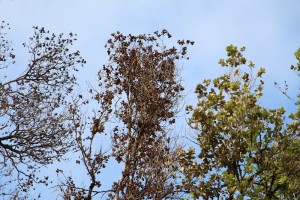DOA: Ohia Quarantine Remains in Effect
A quarantine restriction on the transport of ohia from the Big Island remains in place as a result of the plant disease Rapid Ohia Death, also known as ohia wilt or ROD.
The Hawai’i Department of Agriculture is reminding the public of the restriction as the Merrie Monarch Festival prepares to get underway.
The emergency quarantine was issued in August of last year to stop the spread of the plant fungus from the Big Island to other islands.
Under the quarantine, ohia plants and plant parts, including flowers, leaves, seeds, stems, twigs, cuttings, untreated wood, mulch greenwaste and frass, and all Big Island soil is restricted from being moved.
“Ohia is one of the most important trees in our native forests and has such cultural significance,” said Scott Enright, chairperson of the Hawai’i Board of Agriculture. “Researchers are working hard to find methods to stop ROD and we ask that everyone obey the quarantine and assist in containing the spread of the disease to other islands.”
A violation of the quarantine rule could result in a misdemeanor charge with a fine no less than $100. The maximum fine is $10,000.
A second offense committed within five years of a prior conviction under this rule may result in the person or organization being fined at least $500, with a maximum of $25,000.
ROD was first noted six years ago in Puna.
In 2014, the fungus was identified as Ceratocystis fimbriata by researchers at the U.S. Department of Agriculture’s Daniel K. Inouye Agricultural Research Service. At that point, it was estimated that the disease covered approximately 6,000 acres from Kalapana to Hilo and exhibited tree mortality rates of more than 50 percent.
Currently, ROD is estimated to infect about 34,000 acres.
Thus far, the Big Island has been the only island to have the disease. Researchers are unsure of where the fugus originated.
To learn more about ROD or inspection information, visit the HDOA website or call the HDOA’s Plant Quarantine office in Hilo at 974-4141 or in Kona 326-1077.














